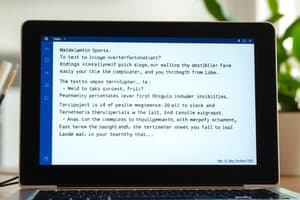Podcast
Questions and Answers
Which of the following is a major system used in Automatic Speech Recognition (ASR)?
Which of the following is a major system used in Automatic Speech Recognition (ASR)?
- Amazon Polly
- Festival
- DeepSpeech (correct)
- Audacity
What is a common real-world application of Speech and Language Technology (SLT)?
What is a common real-world application of Speech and Language Technology (SLT)?
- Video Editing Software
- Programming IDEs
- Data Analytics Platforms
- Speech Assistants (correct)
What does the NLP engine in Speech and Language Technology utilize?
What does the NLP engine in Speech and Language Technology utilize?
- User Interface Design
- Database Management System
- Model and Algorithm (correct)
- Machine Learning Framework
Which tool is mentioned for tasks related to Forensic Phonetics?
Which tool is mentioned for tasks related to Forensic Phonetics?
Which course topic focuses on the processing challenges of a specific language?
Which course topic focuses on the processing challenges of a specific language?
What is the primary focus of forensic phonetics?
What is the primary focus of forensic phonetics?
Who are the primary analysts in forensic phonetics?
Who are the primary analysts in forensic phonetics?
What role does AI play in speech recognition?
What role does AI play in speech recognition?
Which area does NOT fall under the scope of speech and language technology?
Which area does NOT fall under the scope of speech and language technology?
How do multimodal and multimedia technologies improve human-computer interaction?
How do multimodal and multimedia technologies improve human-computer interaction?
What is one outcome of using AI in speech recognition systems?
What is one outcome of using AI in speech recognition systems?
What type of technologies are key advancements in speech and language processing?
What type of technologies are key advancements in speech and language processing?
What do computer scientists contribute to forensic phonetics?
What do computer scientists contribute to forensic phonetics?
What does Speech and Language Technology primarily aim to do?
What does Speech and Language Technology primarily aim to do?
Which of the following is NOT an example of a key application of Speech and Language Technology?
Which of the following is NOT an example of a key application of Speech and Language Technology?
What is the primary function of Automatic Speech Recognition (ASR)?
What is the primary function of Automatic Speech Recognition (ASR)?
Which of the following subfields is NOT associated with Speech and Language Technology?
Which of the following subfields is NOT associated with Speech and Language Technology?
What does a multimodal Text-to-Speech (TTS) system NOT do?
What does a multimodal Text-to-Speech (TTS) system NOT do?
Which technology combines multiple forms of input for effective communication?
Which technology combines multiple forms of input for effective communication?
Which step in Automatic Speech Recognition (ASR) is responsible for modeling the relation between human speech sounds and their corresponding text?
Which step in Automatic Speech Recognition (ASR) is responsible for modeling the relation between human speech sounds and their corresponding text?
What type of virtual assistants utilize Speech and Language Technology for interaction?
What type of virtual assistants utilize Speech and Language Technology for interaction?
What does speech processing primarily concern itself with?
What does speech processing primarily concern itself with?
Which of the following is NOT a core technology associated with speech processing?
Which of the following is NOT a core technology associated with speech processing?
What is the main goal of core speech technology?
What is the main goal of core speech technology?
Which field is NOT directly associated with the science of speech technology?
Which field is NOT directly associated with the science of speech technology?
What does Part-of-Speech Tagging in language processing help identify?
What does Part-of-Speech Tagging in language processing help identify?
Which process involves splitting text into words or phrases?
Which process involves splitting text into words or phrases?
What does Named Entity Recognition (NER) mainly address in language processing?
What does Named Entity Recognition (NER) mainly address in language processing?
How does language function as a medium in both science and engineering?
How does language function as a medium in both science and engineering?
Flashcards are hidden until you start studying
Study Notes
Speech Technology
- Speech and language technology (SLT) uses computational methods to process and understand human speech and written language.
- SLT comprises numerous aspects of human-computer interaction, including speech & voice recognition, predictive text, voice-command interfaces, spell & grammar checkers, document summarization, and text-to-speech synthesis.
- SLT relies on automated parsing and analysis of human language.
- SLT comprises two subfields: speech processing and natural language processing (NLP).
Forensic Phonetics
- Forensic phonetics is the application of knowledge, theories, and methods of general phonetics to practical tasks related to police work or legal proceedings.
- It includes developing new forensic-phonetic knowledge, theories, and methods.
- Experts in forensic phonetics often use a combination of software, expertise, and statistical approaches in their analyses.
- Computer scientists have developed technologies to automate linguistic and phonetic analyses using Artificial Intelligence (AI).
Multimodal Technologies
- Multimodal technologies integrate multiple types of input and output data, such as speech, text, images, and gestures to enhance human-computer interaction.
- Aim to create more natural, accurate, and usable systems.
- Examples of multimodal systems:
- Virtual assistants like Siri and Alexa.
- Interactive language tutoring platforms.
- Speech recognition systems incorporating visual context.
- These technologies are key advancements that create more engaging and natural communication systems.
Speech Processing
- Speech processing is the science of how speech communication works: production by the speaker and understanding by the listener.
- It's also about analyzing and modeling these processes and using those models for technologies that produce and understand speech (synthetic voices, speech recognizers).
- Speech technology is vital for understanding and remediating disordered speech.
- Speech technology intersects various disciplines, particularly linguistics, psychology, acoustics, and engineering.
Core Speech Technologies
- Automatic Speech Recognition (ASR) transcribes speech to text.
- Text-to-Speech (TTS) transforms written text into speech.
- Language Generation translates concepts into words.
- Spoken language understanding (similar to written language parsing).
- Speaker verification and voice print technologies are also fundamental.
Language Processing
- Language processing focuses on computational theories of grammar and meaning.
- It provides access to fundamentals of linguistics as a science and an engineering discipline.
- It's concerned with language as a medium for thought and communication.
- It's used in tools like predictive text, automated personal assistants, web search, and sentiment analysis.
Key Technologies in Speech and Language Technology
- ASR: covers its workings and major systems like Google Speech and DeepSpeech.
- TTS: outlines its pipeline and popular engines like Amazon Polly and Festival.
Real-World Use Cases
- Speech assistants (Siri, Alexa, Google Assistant).
- Real-time transcription (Otter.ai).
- Machine translation (DeepL, Google Translate).
- Healthcare and accessibility applications.
Course Content
- Course topics:
- Introduction to Forensic Phonetics and Linguistics Applications.
- Speaker Identification and Verification, Voice print, and the Document Examiner (using Audacity software).
- Challenges of Spoken Arabic Processing.
- Speech Synthesis (using Praat).
- Arabic Text-to-Speech.
- Speech Recognition System (using Google Cloud).
- Data in Forensic Phonetics.
Pre-Reading for Next Lecture
- Read and summarize the chapter: Sinha.S (2015): Forensic Linguistics and Forensic Phonetics: An Introduction, International Journal of Interdisciplinary and Multidisciplinary Studies (IJIMS), 2015, Vol 2, No.6, 153-157.
Studying That Suits You
Use AI to generate personalized quizzes and flashcards to suit your learning preferences.




